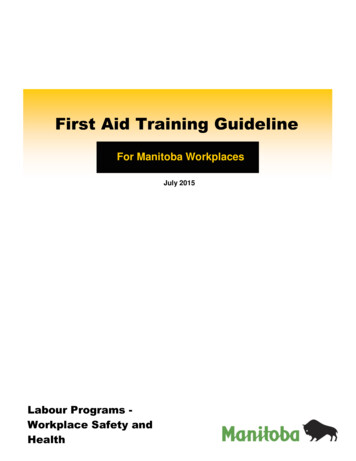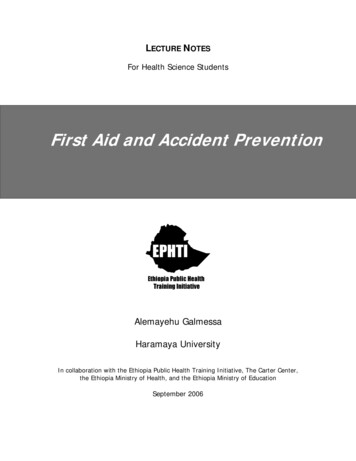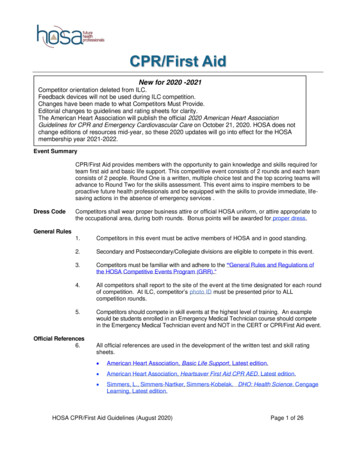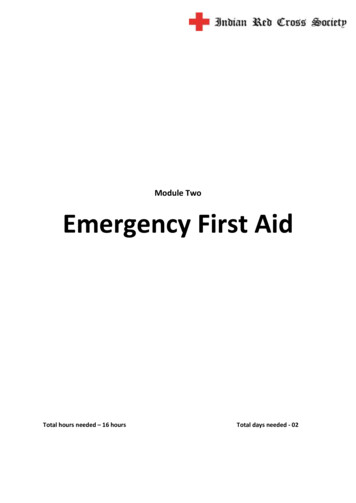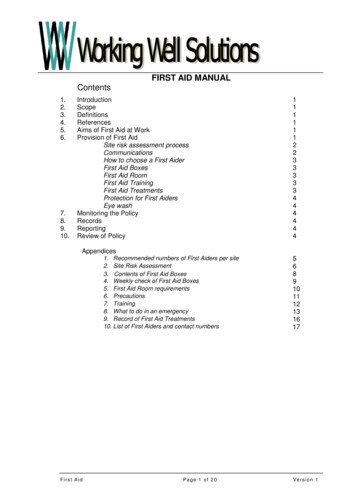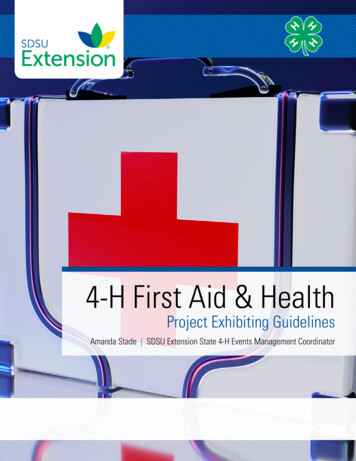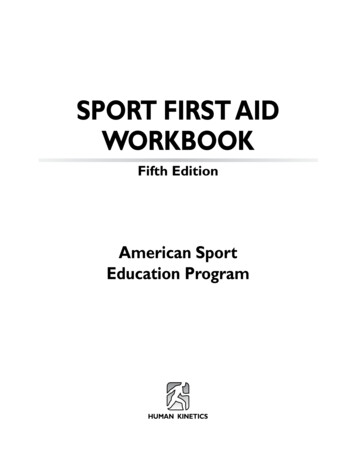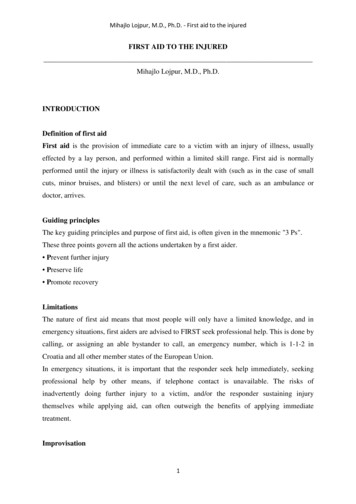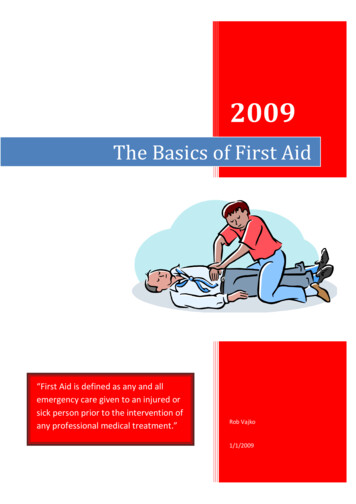
Transcription
2009The Basics of First Aid“First Aid is defined as any and allemergency care given to an injured orsick person prior to the intervention ofany professional medical treatment.”Rob Vajko1/1/2009
www.nationalsafetyinc.comThe Basics of First AidDefining “First Aid”First Aid is defined as any and all emergency care given to an injured or sick person prior to theintervention of any professional medical treatment.The purpose of first aid1.2.3.4.5.To preserve and sustain the life of the casualtyTo Stabilize the patientTo prevent contaminationTo aid in better and more rapid recoveryTo aid in the safe transportation of the patient to a hospital of doctorPoints to be clear on1. The administrator of first aid is NOT A DOCTOR. The role of the first aider is to help keep thepatient alive, as comfortable as possible in order to facilitate the doctor’s job when he or shearrives.2. The first aider should NEVER give up on a patient and terminate life-saving endeavors. Only adoctor should declare a patient dead and stop life-saving procedures.3. Though first aid training is recommended and advisable, you should not allow lack of trainingand/or experience keep you from trying to administer first aid. Your efforts may save a life.Page 2 National Safety, Inc.
www.nationalsafetyinc.comPart One – Scene Assessment, Safety andPersonal Protective EquipmentBeing aware of safety issues can make the difference between saving the patient and becoming anotherone of the victims.Instances are too numerous to mention of people who have rushed to help someone else only tobecome a victim as well. Confined Space deaths, for example, count more deaths by rescuers than bythe original victim. Seeing someone collapse, rescuers rush to his assistance without realizing that thereason for the collapse of the victim had to do with an oxygen deficient environment or an elevatedlevel of some fatal gas. The rescuers end up becoming victims as well.Emergencies are, by their very nature, volatile situations and, as such the danger of further injury isincreased.Obvious, immediate dangers include such things as downed power lines, floods, traffic, potentialcollapses in the immediate vicinity, violence by others, unstable ground to name only a few.You need to be aware of which situations you and others around you can control and which ones youwill need the help of emergency personnel (Police, Power Company, Hazmat team, etc )REMEMBER: You cannot help someone else if you become a victim yourself!Beyond the obvious and immediate dangers, there is also the issue of blood borne pathogens and otherissues related to bodily fluids and infectious diseases (Hepatitis, HIV, etc ).PPE (Personal Protective Equipment) such as disposable gloves, CPR Barriers and eye protection may benecessary. Just because these dangers are not immediate (the effects may take years to showthemselves) or visible does not diminish the threat. You need to protect yourself from contamination.Page 3 National Safety, Inc.
www.nationalsafetyinc.comPart Two – Providing First AidThe ABCs of First AidThe ABCs stands for AirwayMake sure that the airway is clear. Tilt the head back, lift the chin so that the Jaw is thrustforward in order to make sure the airway is clear. BreathingLook and listen for signs of breathing. Try to feel for breath. Allow 3 to 5 seconds. CirculationFeel for a pulse using the second and third fingers and running them along the outer edge of thewindpipe in the neck. Because this artery supplies a massive amount of blood to the brain, this isusually the easiest pulse to detect. Taken 5 to 10 seconds.Additional things to pay attention to: Notice the color of the persons’ skin. Blue, grey or purple colors usually indicate illness.Try to smell for alcohol on the breathListen for groaning noises or rasping in the breathing.Listen for coughing or splutteringPage 4 National Safety, Inc.
www.nationalsafetyinc.comGeneral First Aid ProcedureALWAYS CALL 911 FIRST (or have someone else call if more than one person is present)Page 5 National Safety, Inc.
www.nationalsafetyinc.comNormal Vital Signs: Breathing: 12-20 breaths per minute for adults or 20-25 times per minute for childrenPulse: 60-80 beats per minute (adults) or 80-100 beats per minute for childrenBody Temperature: 98.6o FBlood Pressure: 120 over 80Other issues to keep in mind Always call 911 first. If you are alone with the patient than call 911 yourself. If others arepresent have them call 911Do not move the patient unless it is absolutely necessary for survival. Professional medicalpersonnel will arrange for transport.There may be more than just one injury that needs to be treatedPage 6 National Safety, Inc.
www.nationalsafetyinc.comPart Three – Treating Specific ProblemsTreating BleedingExternal Bleeding For minor cuts and wounds - Clean and dress the injury. For major bleeding - Apply constant and direct pressure to the bleeding and elevate the injuredarea if at all possible. DO NOT apply a tourniquet except as a last resort and only for 15 minutesor less as a tourniquet could, if not properly used, result in the loss of the limb.Internal BleedingIf a person is pale, has a rapid pulse, a weak pulse, labored breathing, cold and clammy skin and/or issweating excessively, they may have internal bleeding. If conscious, treat the patient for shock (See section on shock below).Keep the patient on his or her back with raised legs.Keep the patient warm until professional medical help arrives.Treating severed limbs or body parts1. Immediately wash the severed part with clean water to prevent contamination2. Pack it in a plastic bag and put it on ice3. Get the patient and the severed part to the hospital immediately.Page 7 National Safety, Inc.
www.nationalsafetyinc.comTreating BurnsThere are three possible degrees of burns. The degree of severity will determine the method oftreatment. First Degree – Though there may be intense pain, the skin is only reddened and there are noblisters. First degree burns do not require professional medication treatment. Simply cool thearea with cool water (DO NOT USE ICE! Ice will actually cause further burn). Blot it gently applyburn jel or burn cream and cover with a sterile dressing.Second Degree – Skin develops blisters and may be wet, shiny or “weeping”. Do not touch orcover the burn area. Try to sit the patient up (if possible, try to keep the burn area above heartlevel, especially for arms or legs) and watch for difficulty breathing. Get the patient immediatemedical attention.Third Degree – The skin is very badly burnt. The epidermis (the upper layer of skin) and possiblythe dermis (the lower layer of skin) has been destroyed. Burn area will often appear white,almost purple or black because of the dead skin. Third degree burns are often much less painfulthan first or second degree burns because the nerves themselves have been damaged ordestroyed. Treatment for third degree burns should be the same as for second degree burns. Donot cover as contact with the affected area may cause further damage and increase the risk ofinfection.Electrical Burns – Special care and treatment should be sought for electrical burns as the damage maynot be very evident on the surface but may actually have caused deep muscle damage and even kidneydamage.Chemical Burns – Immediately flush the affected area with large amounts of water. Do not try toneutralize the chemical by adding other chemicals. What may work in a beaker or a test tube mayactually cause further damage when on the skin.Additional note regarding burns: You will want to make sure that the patient has had a recent tetanusshot (within the last 5 years) as burns are highly susceptible to the tetanus infection.Page 8 National Safety, Inc.
www.nationalsafetyinc.comTreating ShockThe body goes into shock when the vital organs aren’t receiving enough fresh, oxygen-rich blood. It isimportant to recognize and diagnose shock as early as possible in order to keep the patient from gettinginto serious and potentially life-threatening trouble.Symptoms of shock include: Low blood pressureVacant stares, bewildered lookExcessive thirstVomitingRapid, irregular and/or shallow breathingRestlessnessPale, cold or clammy skinExtreme and sudden fatigueNauseaWeak or rapid pulseFaintingAnxietyDifferent types of shocksAnaphylactic Shock is the usually brought on by an allergic reaction. This allergic reaction may be causedby a certain type of food, a insect bite or sting and by inhaling something toxic to the person in question.Psychogenic shock, usually referred to as “Shell Shock”, is the result of extreme emotions of fear, angeror grief. The mind, unable to cope, goes into a state of shock that can result in any number of physicalconditions and symptoms.Hypovolemic Shock: This shock is cause by dehydration, bleeding, vomiting, diarrhea or any othercondition that results in an extreme loss of fluids. This decrease of fluids causes a drop in blood volume.This decreased blood volume can result in damage to internal organsWhat to do for shock Loosen clothing to allow patient to breathe better and facilitate circulationDo not give the patient anything to eat or drinkCover the patient with a warm blanketLay the patient on his or her back with legs elevatedPage 9 National Safety, Inc.
www.nationalsafetyinc.comTreating FracturesA fracture is a break or splinter in a bone. It can be caused by violent impact or by any number ofdiseases that cause bone decay.There are several different classifications of fractures:1. Greenstick fracture – which is a simple crack in the bone. They can be determined by a doctorusing an x-ray machine.2. Closed or “simple” fracture – in which the broken bone has not pierced through the skin.3. Open or “compound” fracture – in which the broken bone has pierced or torn the skin resultingin an open wound.4. Comminuted or “multiple” fracture – in which the bone is broken in more than one place.Closed fractures may not be immediately visible and may be difficult to diagnose. If in doubt, treat it as afracture.To treat a fracture:1. Try to avoid moving or jarring the limb2. Support the limb with a splint (stick, rolled newspaper, etc secured with rope, strips of cloth,tie, etc to keep the limb completely rigid.3. Make sure that the splint isn’t too tight by checking for a pulse at the extreme of the limb inquestion. The absence of a pulse would indicate that the splint is too tight.4. Apply ice or frozen vegatables (frozen peas work well) to keep the swelling down but not formore than 20 minutes at a time.5. Do not try to set the bone or repair the fracture.Page 10 National Safety, Inc.
www.nationalsafetyinc.comTreating Choking incidentsChocking, or airway obstructions, are caused when the windpipe is obstructed by a foreign object. Theobstruction can be partial where the windpipe isn’t completely blocked and the patient can still breathebut with some difficulty or it can be complete where the windpipe is completely blocked and the patientcannot be allowed any oxygen at all.The purpose of first aid for chocking is to get the person to expel the foreign object and clear thewindpipe. Coughing, slaps on the back or abdominal thrusts will often do the trick. If not, then theHeimlich maneuver may be necessary. Avoid using the Heimlich maneuver unless absolutely necessaryas it can be painful and may even injure the person. Use it only when the person cannot talk, cough orbreathe.How to do the Heimlich maneuver(The following information is taken from the Heimlich institute website at www.heimlichinstitute.org)The Heimlich Maneuver for CHOKING ADULTSA choking victim can't speak or breathe and needs your help immediately. Follow these steps tohelp a choking victim:1. From behind, wrap your arms around the victim's waist.2. Make a fist and place the thumb side of your fist against the victim's upper abdomen, below theribcage and above the navel.3. Grasp your fist with your other hand and press into their upper abdomen with a quick upwardthrust. Do not squeeze the ribcage; confine the force of the thrust to your hands.4. Repeat until object is expelled.UNCONSCIOUS VICTIM, OR WHEN RESCUER CAN'T REACH AROUND VICTIM:Place the victim on back. Facing the victim, kneel astride the victim's hips. With one of yourhands on top of the other, place the heel of your bottom hand on the upper abdomen below therib cage and above the navel. Use your body weight to press into the victim's upper abdomenwith a quick upward thrust. Repeat until object is expelled. If the Victim has not recovered,proceed with CPR.The Victim should see a physician immediately after rescue.Don't slap the victim's back. (This could make matters worse.)Page 11 National Safety, Inc.
www.nationalsafetyinc.comThe Heimlich Maneuver for CHOKING INFANTSA choking victim can't speak or breathe and needs your helpimmediately.Follow these steps to help a choking infant:Lay the child down, face up, on a firm surface and kneel orstand at the victim's feet, or hold infant on your lap facingaway from you. Place the middle and index fingers of bothyour hands below his rib cage and above his navel. Press intothe victim's upper abdomen with a quick upward thrust; do notsqueeze the rib cage. Be very gentle. Repeat until object isexpelled.If the Victim has not recovered, proceed with CPR. TheVictim should see a physician immediately after rescue.Don't slap the victim's back. (This could make matters worse.The Heimlich Maneuver for CHOKING (ONESELF)When you choke, you can't speak or breathe and you need help immediately. Follow these stepsto save yourself from choking:Page 12 National Safety, Inc.
www.nationalsafetyinc.com1. Make a fist and place the thumb side of your fist against your upper abdomen, below theribcage and above the navel.2. Grasp your fist with your other hand and press into your upper abdomen with a quick upwardthrust.3. Repeat until object is expelled.Alternatively, you can lean over a fixed horizontal object (table edge, chair, railing) and pressyour upper abdomen against the edge to produce a quick upward thrust. Repeat until object isexpelled.See a physician immediately after rescue.Page 13 National Safety, Inc.
www.nationalsafetyinc.comTreating Breathing ProblemsThere are numerous complications that can arise when a body isn’t getting adequate amounts ofoxygen. Asthma, hyperventilation and panic attacks are three of several conditions that can result inbreathing problems.AsthmaAsthma is a chronic disease that causes the airways to constrict, become inflamed or accumulatesexcessive amounts of mucus. These attacks may be triggered by a number of different factors includingcigarette smoke, pollen, cold air, warm air, pet dander and any number of other airborne particulates.Additionally the triggers may be brought on because of emotions or excursions. Asthma can be severeand, in extreme cases, the attacks can be fatal.Helping someone who is having an asthma attack Help the sufferer sit upright as it is easier for them to breathe in this position than if they arelaying down. Try to calm them. Talk with a soothing voice. Do not panic and add to the emotional stress thatthe sufferer is already experiencing. Any additional stress will just make matters worse. Get them to take their medication. Help them if they can’t take it for themselves. Shake theinhaler and give them one good puff. Have them hold the breath in for 4 seconds or so followedby 4-5 normal breaths. Repeat this procedure up to four times. If, after 4 minutes there is noimprovement you should repeat the procedure. If there is still no improvement in the sufferers condition, call 911 and stay with them until helparrives.Panic AttacksPanic attacks are characterized by a sudden sense of fear or anxiety that can leave the person withlabored breathing along with a host of other symptoms. There is usually no visible or explainable reasonfor the onset of this attack and the patient often believes that they are having a heart attack the firsttime that it happens. The reasons why a person may have a panic attack can be biological, hormonal,hereditary or psychological. They are not usually dangerous and when the person can be kept calm, theyusually subside without leaving any physical effects.Helping someone who is having a panic attack Help the sufferer sit upright as it is easier for them to breathe in this position than if they arelaying down. Try to calm them. Talk with a soothing voice. Do not panic and add to the emotional stress thatthe sufferer is already experiencing. Any additional stress will just make matters worse. Try to help them slow their breathing by having them breathe with you. Pause for a couple ofseconds at the end of each breath and hold it in before walking through the cycle again.Page 14 National Safety, Inc.
ilation is brought about when fear or intense emotions cause a person to breathe too heavily.The increase of oxygen in the body causes the carbon dioxide concentration in the blood to drop belowits normal level which in turn raises the pH levels and results in a constriction of the blood vessels to thebrain. Symptoms of hyperventilation may include tingling, lightheadedness, dizziness, headaches andchest pains. The patient may feel that they are having a heart attack.Helping someone who is hyperventilating The treatment for hyperventilation is similar to the treatment for a panic attack except that,initially, it is helpful to have the person loosely hold a paper bag over their nose and mouthwhile breathing. This helps the person increase the amount of carbon dioxide he or she isbreathing in, thereby bringing the level back to normal. Help the sufferer sit upright as it is easier for them to breathe in this position than if they arelaying down. Try to calm them. Talk with a soothing voice. Do not panic and add to the emotional stress thatthe sufferer is already experiencing. Any additional stress will just make matters worse. Try to help them slow their breathing by having them breathe with you. Pause for a couple ofseconds at the end of each breath and hold it in before walking through the cycle again.Page 15 National Safety, Inc.
www.nationalsafetyinc.comTreating ConcussionsConcussions are caused when a sudden impact to the head occurs. This sudden impact can cause thebrain to “bounce around” in the skull resulting in bruising and swelling of the brain. As with any injury tothe brain sensory input and output can be temporarily damaged and must therefore be dealt withimmediately.Symptoms of a concussion may include the following: Speech impairmentBlurred visionConfusionDisorientationInability to concentrate or focusHeadachesDizzinessSeizuresBleeding from the earsDilated pupilsParalysis of any of the limbs or of either side of the faceLoss of consciousnessHow to treat someone with a suspected concussion: Lay the patient down on his or her back with legs elevated over the head and loosen all clothing.Apply a damp cloth to face and neckDO NOT GIVE THEM ANYTHING TO DRINK, even if they ask for it.Although most concussions do not require any additional medical treatment except rest, it is importantto note two very important facts related to concussions:1. Trauma to the brain kills over 50,000 people each year. Many of these patients exhibited noimmediate symptoms and the injury seemed to be a minor one. This means that it is better tobe safe and to have a patient checked out by a professional if there is the least doubt.2. Damage from concussions can be cumulative. It is therefore essential to keep the headprotected by using hard hats, bump caps and helmets. It is also essential to use seatbelts whiledriving.Page 16 National Safety, Inc.
www.nationalsafetyinc.comTreating SeizuresA seizure is essentially a short in the communication between the body and the brain. It is important tonote that not all seizures result in convulsions (unlike what most people tend to believe).There are two classifications of seizures. The first type can be either simple or complex (see below):1.Partial seizures (also called “focal seizures”)A. Simple partial seizures – the patient remains conscious and still has control of his or hermotor skillsB. Complex partial seizures – the patient looses consciousness either right away or after awhile.2. Generalized seizures which happen when abnormal activity is present on both sides of thebrain.How to treat someone who is having a seizure:First of all, it must be clear that there are a number of myths or beliefs about seizures that must beaddressed.1. It is not true that a person having a seizure can swallow his tongue. Most likely thismisconception arose because the patient wasn’t turned onto one side to keep his airway clear(see below). DO NOT attempt to pry the patients mouth open or try to hold the tongue down.2. Do not try to hold the patient down or to try to stop his movements. This only increases thepossibility of injury to the patient and to you.3. Do not attempt artificial respiration except if the patient stops breathing after the seizure (this isextremely unlikely however).So, now that we know what not to do, what is it that we should do?1. Basically all that you can do is to keep the person comfortable and safe till the seizure runs itscourse.2. Time the seizure as this information might be important to the doctor.3. Clear the area around the person to keep him or her from striking anything that might causeinjury.4. Roll them on their side to help clear the airways and help them breathe.5. Remain calm and reassure the patient.6. Stay with them until the seizure has ended.Additionally, you will want to try to find a way to get the person home without them having to drivethemselves (offer to drive them, call someone who can come get them or call a taxi).Page 17 National Safety, Inc.
www.nationalsafetyinc.comTreating DiabetesEmergencies as they relate to diabetes are either of the hyperglycemic or the hypoglycemic nature.Hypoglycemia has to do with low blood sugar and this imbalance usually hits fairly rapidly and mostoften when the person is active. Symptoms of hypoglycemia include excessive sweating, seizures, losingconsciousness or falling asleep suddenly, disorientation, rapid pulse, confusion or sudden onset ofhunger.How to treat someone with hypoglycemia.1. Give the patient something sweet in order to raise the sugar level (only if the patient isconscious).2. Call 911 immediately if the person is unconscious or goes into a seizure.Note to those who are hypoglycemic:1. Always carry something sweet with you (candy, fruit, etc ) or glucose tabs (available indrugstores)2. Glucagon is an injectable medication which rapidly raises blood sugar levels. Keep some handyand train a family member in how to administer the shot.3. Be aware of the onset of this problem. Know when to pull off the road if you are driving; knowwhen to make sure others around you know what is happening so that they can takeappropriate action.Hyperglycemia has to do with high blood sugar and this imbalance usually is slower to hit. Symptoms ofhyperglycemia include excessive thirst, blurry vision, fatigue or drowsiness and a strong smell similar tonail polish remover on breath. If the person loses consciousness there is a possible onset of a diabeticcoma which can be extremely dangerous.How to treat someone with hyperglycemia.1. Call 911 or get them to the emergency room if unconscious or if a blood test of the blood sugarlevels shows abnormally high levels.2. If the person is conscious and able to administer an insulin shot to himself, allow him to and aidif they ask for your assistance. Do not administer an insulin shot to an unconscious person.3. Do not feed them anything as most food and drink has at least some sugar in it and may furtheraggravate the situation.Page 18 National Safety, Inc.
www.nationalsafetyinc.comTreating eye injuriesAs hard as we may try to remove all hazards and protect ourselves, eye injuries can and will occur.Knowing what to do when the injury occurs is crucial. Often time is of the essence.Treating a person who has something in his eye.1. Do not rub the eye or allow the patient to rub his eye. Rubbing will further irritate.2. Wash hands thoroughly with soap and water to remove any possibility of further contamination3. Flush the eye using an approved eye wash4. If you can see the object try to remove it with a clean, lint-free cloth. Pull the top eyelid over thebottom eyelid to try to use the bottom eyelashes to pull the item free.5. If you cannot get the object out, seek immediate medical attention.Treating a chemical Splash or other chemical exposure1. If the injured person is wearing contact lenses, remove the lenses immediately to keep the lens fromtrapping the chemical in the eye.2. Flush the eye for 15 minutes straight to dilute and remove the chemical from the eye.3. Seek immediate medical attention and, if possible, bring the bottle or the MSDS sheet with you.Treating cuts or punctures to the eye1. Protect the eye and seek immediate medical attention. Keep the bandage from touching the eye usinga eye cup or the cut out bottom of a paper cup.2. Do not rinse, apply pressure or give the patient aspirin, ibuprofen or other anti-inflammatory drugswhich might thin the blood and increase bleeding.Treating a blow to the eye1. Gently apply a cold wash cloth or compress to help reduce swelling. Do not apply pressure.2. If the patient has blurred vision or other visual problem, seek medical attention.Page 19 National Safety, Inc.
www.nationalsafetyinc.comTreating light burnsUnlike other eye injuries, injuries related to lasers, welding and other radiant light sources may not beimmediately detected. It may take several hours before the eye starts to feel irritated, as if there weresand in the eye. It may get severely bloodshot, or red, or it may swell. This may be as long as 12 hoursafter the exposure to the light. If this happens, cover the eye to avoid further irritation and get medicalattention.In any and all cases, you are better off getting professional medical help as soon as possible. Many eyeinjuries may not look that severe at first but could potentially result in permanent damage includingpermanent loss of vision.Page 20 National Safety, Inc.
www.nationalsafetyinc.comTreating Heat Related Disorders and DehydrationThe human body is extremely sensitive to changes in temperature and even minor changes canadversely affect it. A rise of less than 7oF above normal body temperature can result in death. The bodynormally handles heat by sweating to cool the body off. It is therefore critical to make sure that thebody remains hydrated, especially in areas of elevated temperature and extreme activity.Heat related disorders include heat rash, heat syncope, heat cramps, heat exhaustion, heat stress, heatstroke and dehydration.Dealing with heat rash – Heat rash is usually due to moist clothing remaining in contact with the skin.Even once the skin has been cleaned and dried, the rash may persist for up to 3 weeks afterwards. Toavoid heat rash try to wear moisture wicking clothing that pulls the moisture away from the skin. Nospecial treatment is necessary for heat rash. It will eventually clear up on its’ own.Dealing with heat syncope – Heat syncope is generally not very serious. It is a dizziness that comesfrom overheating while sitting in the sun. Simply move the person to a shaded area and cool them downand the problem should go away. Give them plenty of liquids a little at a time to make sure that theyaren’t getting dehydrated.Dealing with heat cramps – Heat cramps are caused by dehydration. When the muscles are low insodium and fluids they may cramp up or spasm. Rehydration will usually remedy the problem (seebelow).Dealing with dehydration - First it must be noted that it is much simpler to make sure that the bodystays hydrated than it is to try to rehydrate a body that has become dehydrated. Drinking plenty ofliquids (avoid caffeinated or alcoholic beverages) is key to keeping the body hydrated. Symptoms ofdehydration may include fatigue, cramping, dizziness, confusion, extreme thirst, headaches, fainting,and convulsions. To help a victim of dehydration give them small doses of liquids (electrolytereplacement drinks and/or tablets are a great way to rehydrate because they replace the neededelectrolytes as well as the liquids) at regular intervals; too much to fast could cause the person to vomitand actually lose even more liquids, so give small doses a little at a time. Move the person to a coolerlocation. The urine of a well hydrated person will run clearish (as opposed to dark yellow).Dealing with heat exhaustion or heat stress - When dehydration continues, the lack of fluids inthe body can cause the constriction of the blood vessels which will may result in lightheadedness,dizziness, exhaustion, cramping, fatigue, increased respiration, etc Rehydration should remedy theproblem. If left untreated, however, it could potentially lead to heat stroke which can be fatal (seebelow)Page 21 National Safety, Inc.
www.nationalsafetyinc.comDealing with heat stroke – As we have already mentioned, heat stroke can be fatal. If the bodytemperature gets too elevated the brain can overheat. Death can result in as little as 30 minutes so it isimperative to get them help immediately.Heat stroke can be:1. Slow (fluid depleted heat stroke) which comes about when dehydration is ignored. Eventually,the lack of fluids in the body causes the body to overheat, leading to heat stroke.2. Fast (fluid intact) which comes about, not as a result of fluid depletion but as a result of extremeheat when the body isn’t able to cool itself down adequately or fast enough.In either case, heat stroke symptoms may include any of the followi
The Basics of First Aid Defining “First Aid” First Aid is defined as any and all emergency care given to an injured or sick person prior to the intervention of any professional medical treatment. The purpose of first aid 1. To preserve and sustain the life of the casualty 2
